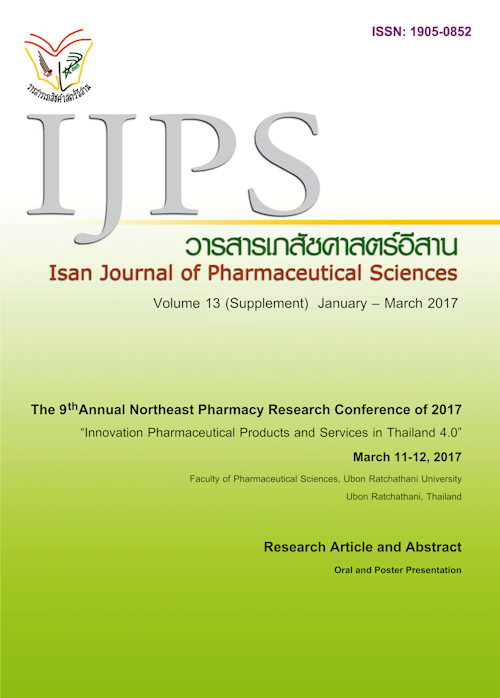Simultaneous Separation of Glycyrrhizic Acid and Gallic Acid in Cinnamon Stomachic Mixture Extract by Thin Layer Chromatography- Densitometric Method and Screening of Anti-free Radical Substances by Bioautographic Method
Main Article Content
Abstract
Introduction: Cinnamon stomachic mixture was a well-known remedy for treatment of flatulence and indigestion in Thai traditional medicine. The mixture were comprised of five herbs [ Syzygium aromaticum (L.) Merr.&L.M.Perry, Amomum krervanh Pierre., Glycyrrhiza glabra Linn., Cinnamomum bejolghota (Buch.-Ham.) Sweet, and Cinnamomum verum J.Presl. ] and two chemicals (menthol and camphor). The aims of this study were to develop TLC mobile phase system for simultaneous separation of 2 compounds (glycyrrhizic acid and gallic acid) and to screen anti-free radical substances by bioautographic method of cinnamon stomachic mixture extract and each herbs in the formulation. Methods: Each five herbs and formulation were boiled with water for 15 minutes, filtered through Buchner funnel with Whatman No.1 filter paper and followed by freeze-drying technique. All extracts were then analysed with TLC method. Six TLC mobile phase systems were investigated for simultaneous separation of glycyrrhizic acid and gallic acid. Bioautography was performed using 1,1 diphenyl 2-pricrylhydrazil (DPPH) spraying reagent for anti-free radical substances screening of the spot on TLC. Results: The best mobile system of TLC analysis was toluene : ethyl acetate : methanol : formic acid (2:5:1:1, %v/v). This system showed Rf values of glycyrrhizic acid and gallic acid at 0.18 and 0.69, respectively. The UV absorption spectra at 200-400 nm of the corresponding spot in the extract confirmed that gallic acid in the mixture was derived from Syzygium aromaticum and glycerrhizic acid was derived from Glycyrrhiza glabra. Gallic acid and other anti-free radical substances were tested with DPPH spraying reagents. Conclusion: In this research, two active ingredients were separated in the same mobile phase system and were detected with densitometry. Bioautography with DPPH spraying reagent could also be used for scanning anti-free radical substances of cinnamon stomachic mixture.
Article Details
In the case that some parts are used by others The author must Confirm that obtaining permission to use some of the original authors. And must attach evidence That the permission has been included
References
Abd El Azim MHM, El-Mesallamy AMD, El-Gerby M, Awad A. Anti-Tumor, Antioxidant and Antimicrobial and The Phenolic Constituents of Clove Flower Buds (Syzygium aromaticum). J Microb Biochem Technol 2014; S8:007. doi:10.4172/1948-5948.S8-007
Jain V, Vyas A, Saraf S. TLC Densitometric Methods for Quantification of Gallic Acid in Triphala Churna for Routine Quality Control. Res J Pharm Tech 2011; 4: 230-233.
Jang HD, Chang KS, Huang YS, Hsu CL, Lee S-H, Su MS. Principal Phenolic Phytochemicals and Antioxidant Activities of Three Chinese Medicinal Plants. Food Chem 2007; 103: 749-756.
Khera D, Kohli K, Parmar N. Development and Validation of Stability-indicating HPTLC Method for Determination of Glycyrrhizic Acid in Bulk Drug and Pharmaceutical Formulations. J Liq Chromatogr R T 2011; 34(15): 1502-1517.
Klejdus B, Kovacik J. Quantification of Phenols in Cinnamon: A Special Focus on “Total Phenols” and Phenolic Acids Including DESI-Orbitrap MS Detection. Ind Crops Prod 2016; 83: 774z780.
Kristasilp K, Tuntiprawan K, Wanleepong K. et. al., The Effectiveness and Safety of The Cinnamon Stomachic Mixture Formulation in Functional Dyspepsia’s Patient Treatment. Siriraj Medical Journal 2006; 58(11): 1103z1106.
Lertsatitthanakorn P, Manwiwattanakun K, Paengnakorn N, Khunkitti W. Antibacterial Activity of an Effective Essential Oil Formulated in Liquid Soap Against Skin Bacteria. Chiang Mai J. Sci. 2014; 41(1): 71-83.
Lin JY, Tang CY. Determination of Total Phenolic and Flavonoid Contents in Selected Fruits and Vegetables, As Well As Their Stimulatory Effects on Mouse Splenocyte Proliferation. Food Chem 2007; 101: 140-147.
Mali DS, Kondawar MS, Kamble KG. Quantitative Estimation of Gallic Acid and Ascorbic Acid in a Marketed Herbal Medicine: Triphala Churna by High Performance Thin Layer Chromatography. Int J Pharm Tech Res 2011; 3: 1593-1599.
Meena AK, Rao MM, Panda P. et al. Standardisation of Ayurvedic Polyherbal Formulation, Pancasama Chuma. Int J Pharmacog Phytochem Res 2010; 2: 11-14.
Pathak SB, Niranjan K, Padh H, Rajani M. TLC Densitometric Method for The Quantification of Eugenol and Gallic Acid in Clove. Chromatograpphia 2004; 60: 241-244.
Patra KCH, Suresh P. Standardization of Polyherbal Siddha Formulation, Amukkara Choornam. Ind J Traditional Knowledge 2009; 8: 449-452.
Rattana S, Sungthong B. Antioxidant Activities and Total Phenolic Contents of Methanolic Extract of Five Fragrant Flowers. The 12th Mahasarakham University Research Conference 2016: 359-365.
Singh B, Mungara P, Nivsarkar M, Anandjiwala S. HPTLC Densitometric Quantification of Glycyrrhizin, Glycyrrhetinic Acid, Apigenin, Kaempferol and Quercetin from Glycyrrhiza glabra. Chromatographia 2009; 70: 1665-1672.
Soonthornchareonnon N., Sothanapanand U, Wongsinkhongman P. TLC: A simple method for qualitative analysis of Thai crude drugs. Thai traditional medicine institution. Department for development of Thai Traditional and alternative medicine. Ministry of Public Health. Thailand; 2008. 202-204.
Veerapan P, Khunkitti W. In Vitro Antioxidant Activities of Essential Oils. IJPS 2011; 7(3): 30-38. Wannissorn B, Jarikasem S, Siriwangchai T, Thubthimthed S. Antibacterial Properties of Essential Oils from Thai Medicinal Plants. Fitoterapia 2005; 76: 233-236.
Yen GC, Duh PD, Tsai HL. Antioxidant and Prooxidant Properties of Ascorbic Acid and Gallic Acid. Food Chem 2002; 79: 307z313.


